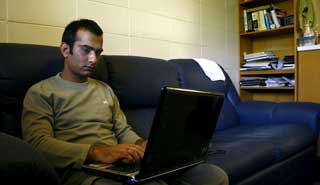Immigration takes more than a visa
Kashif is a first semester graduate student at Eastern.
Kashif has a problem.
He cannot get a driver’s license.
“We are in trouble because I still can’t apply for my (driver’s) license since I don’t have any social security (number) and I don’t know what to do,” Kashif said.
Kashif and his wife, Sadia, are from Pakistan and have lived in the United States for two months.
For the Shahs and other international students at Eastern, the steps in immigration do not end at the airport.
In order to immigrate, the couple had to acquire visas and plane tickets, spending a total of $2,500.
It took the Shahs three months to get to the United States because they had trouble getting social security numbers.
For Sardar Murad, who is also from Pakistan and in his third semester at Eastern in the school of technology, the process was easier.
It took him three weeks to get his visa and $2,000 to immigrate, but said others he knew had more trouble.
“There are specific rules and regulations, and no one will tell you why your application wasn’t approved because there are certain security processes,” Murad said.
Murad said the process of getting a visa included application and admission to Eastern, and the sending of his passport and I-20 form to the U.S. Embassy in Pakistan.
In order to immigrate, Murad said he also had to have a physical check-up.
More important for Murad however was approval from his father.
Murad said because Pakistan has a very family-oriented culture, his father had the last say in whether he could come to America.
“If he said no, I wouldn’t have been able to go,” he said.
Although Kashif and his wife came to the United States for education, Kashif is the only one attending classes currently because he does not have enough money to pay for his wife’s schooling yet.
He takes three courses at Eastern as a technology management major and said he would like to do Optional Practical Training, a type of work-study, as well.
“Next semester she might go because I will have more scholarships and such,” Shah said.
In Kashif’s classes, he said about 90 percent of the students are international.
He said even though his studies are going well, the people in his classes have not yet welcomed him as one of their own.
“Since I am here with my wife, I can’t go out and mingle with other students as I would like to,” Shah said. “I think they probably would try and adjust me to the American culture if I did have the time though.”
Murad said most of his classes are also populated with international students.
“In one of my classes, which consists of 25 people, only one of the students is local,” he said.
Waseek Wahby, professor of construction technology and the coordinator of the industrial technology program, said he thinks the large amount of international students in the technologies is because technology is now global and local.
He also said he thinks students in other countries look up to America as a leader in technology.
“It was natural for them to dream about coming, and then to apply, and then to come,” Wahby said.
He said not all of the technology classes have a higher percentage of international students, but this year he has seen an increase.
“This year, in global technology I have 29 students, 27 are from India and Nepal, and two are from this country,” said Wahby.
In his class, Wahby tries to help students break the ice.
“When they start in the first meeting you have this intimidating atmosphere, particularly when you are coming from another culture. We try to make icebreakers and break them out into smaller groups,” said Wahby.
Wahby said it is important to remember that everyone was a “visitor” at one time.
Murad, like Kashif, said he noticed the opposite of this behavior, however.
He said the local students and the international students in his classes are split.
“As far as I’m concerned, there aren’t very many friendly relationships in my classes. Where I work there are good relationships, but at school the room is usually broken in two and when students need to work in groups outside of class, they just do their thing at the library and leave,” he said.
Murad wants to be a teacher and doesn’t know if he is going to stay in the United States or go back to Pakistan but said he will pick the one with the best opportunities.
Immigration takes more than a visa

Kashif Shah, a graduate student in the technology management program from Islamabad, Pakistan, does research for his online class Wednesday afternoon in the living room at his place in the University Apartments.





































































